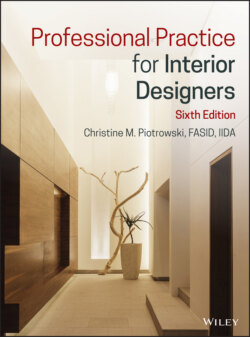Читать книгу Professional Practice for Interior Designers - Christine M. Piotrowski - Страница 32
CHAPTER 2 Professional Advancement
ОглавлениеAs discussed in Chapter 1, a professional must attain certain standards recognized by those in the profession. Interior design professionals and educators often talk about the three Es as a necessary part of the practice of interior design: education, experience, and examination. Although entry into the interior design profession may come in many ways today, the principles of the three Es remain valid.
Professional interior design in the 21st century requires educational preparation in a wide variety of courses specifically within the body of knowledge for interior design. Having a “flair” for decoration is not enough for a professional in the 21st century. Education should continue with professional seminars and workshops for updating and expansion of the professional practitioner's knowledge and skills.
Work experience through internships and/or entry‐level positions in the design industry helps designers see the “real world.” Practitioners gain experience on the job in a wide variety of settings and design specialties, thus preparing themselves for career options.
The third “E”—examination—is a further qualification for the professional interior designer in today's multifaceted world. An examination after completion of education and some period of work experience seeks to test a practitioner's knowledge and skills in the body of knowledge recognized as necessary for practice of the profession. Further, an examination is expected in states that have legal licensing or registration.
After completing this chapter you should be able to:
Explain the three Es and how they relate to the interior design profession.
Discuss why advanced education may be important for some interior designers.
Explain why continuing education is important for all interior designers.
Discuss how an internship program can be beneficial for a student.
Discuss how the interior design profession protects the health, life safety, and welfare (HSW) of clients and the general public.
Explain why it is important for the Council for Interior Design Qualification (CIDQ) to be an independent organization.
Explain why you believe (or don't believe) the National Council for Interior Design Qualification (NCIDQ) examination is important to the profession and a professional.
Investigate the membership requirements of one (or more) of the professional associations paying special attention to student membership.
Compare a practice act to a title act regarding a practitioner's qualifications and impact on the public.
Discuss the pros and cons of affiliating with a design professional association.
